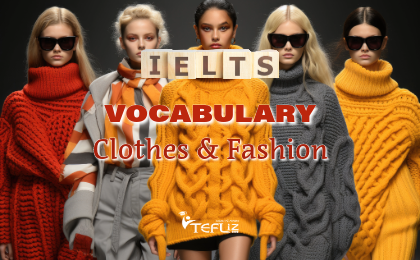The IELTS Speaking test is a fantastic opportunity to showcase your English language skills, and a common topic that comes up is clothes and fashion. This post aims to equip you with a list of IELTS vocabulary and phrases to confidently discuss the subject of clothes and fashion, whether you’re talking about your personal style, the latest fashion trends, or your favourite shopping habits.
Understanding the IELTS Speaking Sections
The IELTS Speaking part is divided into three sections. Part 1 begins with the examiner asking you about familiar topics such as your home, work, or interests, including clothes and fashion. In Part 2, you might be asked to describe something related to clothes, such as your favourite outfit or a piece of clothing you recently bought. Finally, Part 3 involves more abstract questions, such as the fashion industry’s impact on society.
Key IELTS Vocabulary and Phrases for Clothes and Fashion
To impress the examiner, it’s vital to use a range of vocabulary. Here are some IELTS Vocabulary words and phrases categorized by topic to help you confidently navigate questions about clothes and fashion in your IELTS Speaking test.
Types of Clothes
- Casual clothes: Informal attire like jeans, t-shirts, or sneakers.
- Attire: A more formal word for clothes.
- Outfit: The combination of clothes you are wearing.
- Jacket, shirt, trousers: Common items of clothing that you might talk about.
- Wardrobe: The collection of all your clothes.
Describing Fashion
- Fashionable, stylish: Having a good sense of fashion.
- Trendy: Following the latest fashion.
- Avant-garde: Very modern and sometimes shocking styles of clothing.
- Colour, pattern, design: Elements to describe how clothes look.
- Slim-fit, velvet, trendy: Adjectives to describe the style or material of clothing.
Expressions and Idioms
- Dressed to the nines: Wearing very smart or fashionable clothes.
- On a shoestring: Having a very small budget to spend on clothes.
- To have a sense of style: To know what looks good on you and to have your unique style.
Speaking About Preferences
- I tend to prefer wearing…: A polite way to express your clothing preference.
- My go-to outfit is…: Describing your favourite or most common choice of clothing.
- I have a penchant for [velvet]…: Showing a strong liking for a specific material or type of clothing.
Shopping Preferences
- Retail therapy: Shopping as a way of improving mood or emotional state.
- Bargain: An item bought at a lower price than usual, a good deal.
- Wardrobe staple: An essential item of clothing that can be worn on many occasions.
- Fashion-forward: Being ahead in fashion trends, adopting styles before they become popular.
Describing Fit and Comfort
- Figure-hugging: Clothes that fit tightly around the body, emphasizing the shape.
- Loose-fitting: Clothes that are not tight and have plenty of room to move in.
- Made-to-measure: Clothes specifically tailored to fit one person perfectly.
- Off-the-rack: Clothes that are mass-produced and can be bought without alterations.
Materials and Patterns
- Breathable fabric: Material that allows air and moisture to pass through, like cotton or linen.
- Synthetic fibres: Man-made materials such as polyester or nylon are often used in clothing.
- Plaid: A pattern of criss-crossed horizontal and vertical bands in multiple colors.
- Sequined: Decorated with small, shiny discs sewn tightly together for a decorative effect.
Talking About Changes and Trends
- Vintage: Refers to high-quality items from a previous era that are often fashionable again.
- Recycled fashion: Clothes made or styled from previously worn or used garments.
- Fast fashion: Cheaply produced and priced clothes that copy the latest catwalk styles and trends.
- Sustainable fashion: Clothing designed, manufactured, distributed, and used in environmentally friendly ways.
Expressions for Likes and Dislikes
- Not my cup of tea: A polite way of saying you don’t like something.
- To have an eye for fashion: To have a good sense of what clothes look good.
- To wear something to death: To wear a piece of clothing so often that it becomes worn out.
- Mix and match: Combining different items of clothing to create various looks.
Accessories and Extras
- Statement piece: An item of clothing or accessory that is bold and draws attention.
- Jewellery: Objects such as rings, necklaces, or bracelets worn for decoration.
- Handbag: A small bag carried by a person, often a fashion statement beyond its functional use.
- Footwear: Refers to items worn on the feet, such as shoes, boots, and sandals.
Sample Questions and Answers
To give you a clearer idea, here are some sample IELTS Speaking questions and model answers related to clothes and fashion:
“What kind of clothes do you like to wear?”
“I usually prefer casual clothes, especially jeans and a comfy shirt. I believe in dressing for comfort, but I also like to look presentable. My favourite piece is a slim-fit jacket that adds a stylish touch to my otherwise simple outfits.”
“Describe an item of clothing that you recently bought.”
“Recently, I bought a velvet jacket from a local boutique. It’s not just any jacket; it’s deep blue with a subtle sheen that catches the light beautifully. This piece appealed to me because it’s both fashionable and timeless. Wearing it makes me feel confident and stylish, perfect for special occasions.”
“Do you think fashion is important?”
“Fashion is significant as it’s a form of self-expression and can influence first impressions. However, it’s essential to find a balance between following trends and maintaining personal comfort and identity. Fashion should be about individuality as much as it’s about conformity to trends.”
Tips for the IELTS Speaking Test on Clothes and Fashion
- Expand Your Vocabulary: Learn specific vocabulary related to clothes and fashion to describe your preferences and opinions accurately.
- Practice Makes Perfect: Try answering different types of questions about clothes and fashion using different IELTS Vocabulary to build your confidence.
- Be Specific: Provide details in your answers to make them more interesting and engaging.
- Use Idioms and Phrases: Sprinkle your responses with idiomatic expressions to demonstrate your language proficiency.
Clothes and fashion are topics that everyone has some experience with, making them excellent opportunities to showcase your English language skills in the IELTS Speaking test. By preparing with the right vocabulary and expressions, you can approach this part of the exam confidently and leave a lasting impression on the examiner. Remember, the key is to communicate effectively and express your personality through your answers. Good luck!



